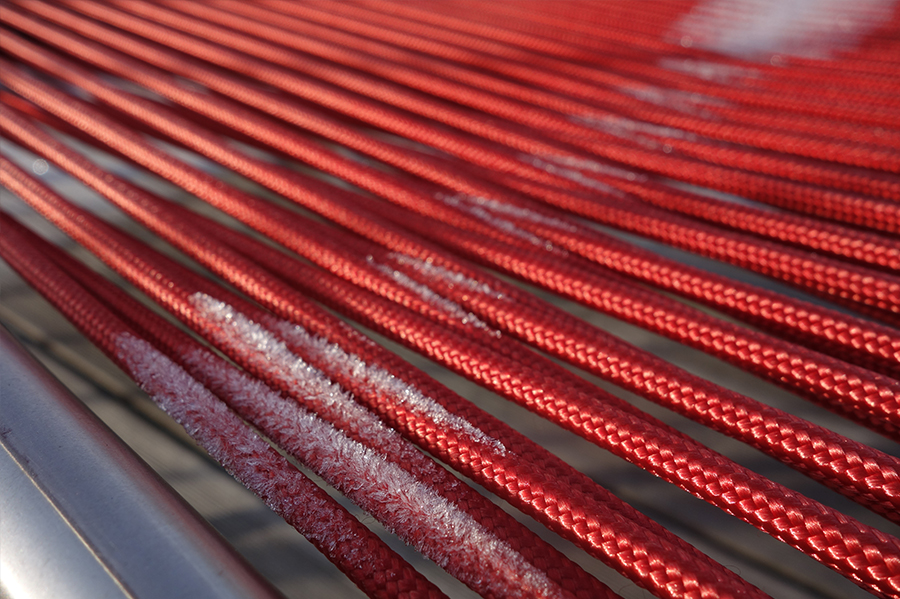Qu’est-ce que le mobilier durable ? Comme d’habitude, la réponse de Google ne sort pas du lot. J’ai trouvé un article de Treehugers qui donne un aperçu de la situation dans son ensemble. Il est évident qu’ils se concentrent principalement sur le bois, mais il est intéressant et il est copié à la fin de cet article.
Tous les meubles conçus par zo2 sont
- fait pour durer
- 100% fabriqués en Suisse avec des entreprises socialement engagées
- il nous a fallu plus d’un an pour trouver les bonnes personnes, qui non seulement connaissent leur métier mais qui gèrent aussi leur “entreprise” de manière socialement durable
- nous aimons vraiment travailler avec les aveugles pour le tressage des cordes pour les parties assises. Et vous sentez la différence !
- nous aimons tester notre conception, la revoir et l’améliorer. Nous avons fait des tests avec les prototypes pendant plus d’un an et nous vous donnons ici quelques impressions :
L’hiver suisse est une bonne épreuve. Non seulement pour le froid, mais aussi pour la résistance aux UV. Ma LC Lounge Chair en est à sa troisième saison sur la terrasse et elle est toujours aussi belle.

Les matériaux dans le mobilier durable
Le mobilier durable est fabriqué à partir de matériaux qui présentent certaines caractéristiques. Ces matériaux peuvent être recyclés ou réutilisés. Tout ce qui est fabriqué à partir de matériaux qui ont déjà été utilisés pour autre chose et qui sont ensuite réutilisés dans la fabrication de nouveaux meubles. Le mobilier durable peut également être fabriqué à partir de matériaux facilement renouvelables. Le bambou pousse facilement et peut être remplacé très rapidement, ce qui permet de l’utiliser comme une ressource renouvelable. Ce n’est qu’un exemple parmi d’autres. L’utilisation de matériaux plus sûrs rend également le mobilier durable. L’utilisation de finitions qui ne dégagent pas de gaz ou sont à faible teneur en COV contribue à sa sécurité dans l’utilisation quotidienne.
Le détail de la chaise longue LC avec la neige fondante :

Pratiques de fabrication durables
L’utilisation de matériaux durables n’est qu’une partie de la production de meubles durables.
Les pratiques de fabrication responsables sont tout aussi importantes et ont un grand impact sur notre planète. Les pratiques de fabrication doivent être sans danger pour l’environnement, ce qui signifie que les fabricants doivent contrôler les émissions de carbone et s’assurer qu’ils ne polluent pas l’environnement. Ils doivent pratiquer un commerce équitable et ne pas nuire aux communautés ou détruire des environnements sensibles pour rassembler des matériaux pour leurs produits.
La chaise longue LC Lounge fait du ski sur corde quand il fait à nouveau froid. Notre corde de ski est résistante aux UV. Vous pouvez également utiliser des cordes recyclées. Normalement, toutes les cordes de montagne ou de voile sont résistantes à l’eau.

Comment a-t-il été transporté ?
Puisque le transport de produits finis, ou même de matières premières pour la fabrication, utilise également de l’énergie, la responsabilité dans le transport fait également partie de la production d’un produit durable.
Si vos meubles ont été importés d’ailleurs, découvrez comment ils ont été fabriqués. Les meubles qui vous viennent d’ailleurs le font en utilisant et en dépensant de l’énergie. Cherchez des entreprises qui transportent leurs marchandises efficacement, et celles qui n’utilisent pas trop d’espace et d’énergie pendant le transport.
La façon la plus efficace d’économiser l’énergie est d’acheter des meubles produits localement, qui ont été construits en utilisant uniquement des matériaux locaux. Cela permettra de réduire l’empreinte carbone.
Le fauteuil LC Lounge Chair après une pluie de printemps :
Son utilité
Le meuble durable doit également être utile pour l’acheteur ou l’utilisateur. Cela signifie qu’il doit être conçu de manière à offrir un maximum de fonctionnalité, de confort et de facilité d’utilisation, et qu’il doit être durable, afin de ne pas devoir être remplacé rapidement.
Tout meuble qui augmente l’efficacité en offrant une plus grande utilité à l’utilisateur, comme un meuble multifonctionnel, est toujours préférable. Il prendra moins de place et résoudra efficacement le problème qu’il est censé résoudre. Par exemple, un canapé-lit qui est conçu pour fonctionner facilement est un meuble très utile.
La durabilité du meuble est également importante, car un meuble bien conçu aura une durée de vie fonctionnelle plus longue. Cela contribue à la santé de la planète en évitant d’ajouter aux décharges
Le LC Lounge Cahir, après 3 ans, a l’air tout neuf. Et je sais que dans 20 ans, cela ne changera pas. Je devrai peut-être changer les cordes, peut-être qu’à ce moment-là j’aurai escaladé le Cervin, alors j’utiliserai ces cordes et je les recyclerai en souvenir de l’ascension. Nous verrons bien. Bonne vie durable !
Pour plus d’informations et de conseils concernant les mobiliers durables: Treehugger
English version
What exactly is sustainabel furniture? As usual the Google answer doesn’t go off mainstream. I found an article by treehugers which gives a hint of the bigger picture. Obviously their focus is mainly on wood, but it is interesting and it’s copied in at the end of this post.
All of zo2’s furniture design is
- made to last
- 100% manufactured in Switzerland with socially engaged companies
- it took us over a year to find the right people, who not only know their craft but are also run their “business” in a socially sustainable way
- we really like to work with the blind people for the braiding of the ropes for the sitting parts. And you feel the difference!
- we like to test our design, review it and improve it. We have done test with the prototypes for over a year and we’ll give you some impressions here:
Swiss winter is a good hard test. Not only for the cold but also for UV resitance. My LC Lounge Chair is now the 3rd season on the terrace and it still looks beautifully.

Materials in Sustainable Furniture
Sustainable furniture is made from materials that have certain characteristics. These materials may be recycled or re-purposed. Anything that is made from materials that had previously been used for something else and are then re-used in the making of new furniture. Sustainable furniture can also be made from material that is easily renewable. Bamboo grows easily, and can be replaced very quickly, so it can be used as a renewable resource. This is just one example. The use of safer materials also makes furniture sustainable. The use of finishes that do not off gas or are low VOC contributes to its safety in everyday use.
The LC Lounge Chair detail with melting snow:

Sustainable Manufacturing Practices
Using sustainable materials is only part of producing sustainable furniture.
Responsible manufacturing practices matter just as much, and have a great impact on our planet. Manufacturing practices have to be safe for the environment, which means that manufacturers should check carbon emissions, and make sure that they do not pollute the environment. They should practice fair trade and not harm communities or destroy sensitive environments to gather material for their products.
The LC Lounge chair skiing ropes when it gets icy again. Our skiing rope is UV resitant. You can also use recyled ropes. Normally all mountain or sailing ropes are water resitant.

How Was it Transported?
Since transportation of finished products, or even raw materials for manufacturing also uses energy, responsibility in transporting is also part of producing a sustainable product.
- If your furniture was imported from somewhere else,find out how it was done. Furniture that comes to you from anywhere else does that by using and expending energy. Look for companies that are transporting their goods efficiently, and those that do not use excessive space and energy during transport.
- The most energy efficient way is to buy locally produced furniture which has been constructed using only locally-sourced materials. This will have a reduced carbon footprint.
The LC Lounge Chair after a spring rain:
How Useful it is
The piece of sustainable furniture should also be useful for the buyer or user. That means it should be designed in such a way that it offers maximum functionality, comfort, and ease of use.It should also be durable, so that it does not need to be replaced quickly.
- Any furniture that increases efficiency by providing greater utility for the user, such as multifunctional furniture is always preferable. It will take up less space and effectively solve the problem that it was meant to address. For instance, a sofa bed that is made to operate easily is a very useful piece of furniture.
- The durability of the piece also matters because well made furniture will have a longer functional lifespan. That contributes to the health of the planet by not adding to the landfills
The LC Lounge Cahir after 3 years just looks as though it is new. And I know that in 20 years this won’t change. I may need to change the ropes, may be by then I will have climbed the Matterhorn, then I will use those ropes and recycle them in memory of the climb. We’ll see. Happy sustainable living!
Top Green Furniture Tips by treehuger http://www.treehugger.com/htgg/how-to-go-green-furniture.html
-
- Certified sustainable wood Whether a piece of furniture is made from wood, cloth, metal, plastic, or whatever else, there are earth-friendly options. When cave people realized that boulders weren’t the most comfortable things to sit on, wood was almost certainly where they looked, so let’s start there. The world needs more trees, not less, so practices that lead to deforestation aren’t any good. Not only do trees absorb carbon dioxide and produce oxygen, they keep the surface of the planet cool, they hold soil together so it can stay rich, and they provide the habitat that animals, insects, birds, and other plants call home, not to mention they support many people’s livelihood. Simply put, don’t mess with the trees. There are sustainable ways to harvest wood, however. Wood from sustainably harvested forests, sustainably harvested tree farms, and reclaimed wood are the main sources. Forest Stewardship Council (FSC) is a great standard of certification that controls clear-cutting and promotes good working conditions.
- Furniture made with reclaimed materials If wood is taken care of, and sometimes even if it isn’t, it can last a really, really long time. So shouldn’t we be able to make good use of all the wood that’s already out there? A lot of designers think so and are doing just that. Reclaimed wood usually comes from old furniture, houses, or other built things that are ready for some friendly reincarnation, from flawed wood, or from scraps from a factory that makes other stuff. Some reclaimed wood even comes from logs that sunk to the bottom of rivers as they were being floated downstream to the sawmill, or from the bottom of man-made reservoirs (check out the Sawfish). Either way, furniture made from reclaimed wood is a great example of resource efficiency, but usually comes in shorter supply. The Rainforest Alliance has a Rediscovered Wood Certification label to look for.
- BambooYou’ve probably heard by this point that bamboo isn’t a tree at all, but a grass. Bamboo represents a family of grasses that range in size from tiny to huge, and in color from lime green to maroon stripes. It is incredibly fast-growing and versatile and has become the unofficial poster material of environmental designers and builders. Bamboo can be flattened into flooring, molded into furniture, pressed into veneers, sliced up to make window blinds, or hey, you can just build your whole house out of it. Using bamboo in buildings can earn architects and builders LEED points if they are careful about where they source it from. Most bamboo comes from China and is grown with few or no pesticides. Because it is so fast growing, it is much easier to maintain healthy bamboo forests. This also means it uses a lot of water, however, and harvesting too fast can deplete soil fertility. Some growers do use pesticides and other chemical inputs, however, so keep that in mind. Another thing to be wary of is that bamboo products are pieced together with glue – which can contain formaldehyde, depending on the supplier. The fact is we still don’t know how green bamboo furniture is.
- Recycled metal and plastic More and more furniture is being made from recycled plastics and metals as well, like the recycled aluminum Icon Chair. Recycled materials require less processing and fewer resources, and help support the market for recycled materials. Technologies are always improving, meaning that recycled plastics and metals are always going up in quality. It’s not all about materials, though, so here are some basic guiding principles to keep in mind when looking for furniture. There are lots of things that claim to be recyclable; it is a meaningless and loaded word. Everything is recyclable if you are willing to spend the money to do it; that’s why coffee pod manufacturers are spending money to take back their pods and turn them into lawn chairs and garden compost; it makes people feel good. Making things out of virgin materials and calling it recyclable is marketing, nothing more.There are exceptions. Products certified Cradle to Cradle (C2C) like certified office chairs from Herman Miller and Steelcase, can be easily taken apart, sorted into their constituent parts, and recycled at the end of their useful lives. They may start with virgin material but it is designed to be recyclable. When buying furniture, stay away from “monstrous hybrids”, pieces that are an inseparable amalgam of materials. If they can’t be taken apart it’s probably a sign that they can’t be repaired very well eithe
-
- Recyclable and disassemblable
Good eco-friendly furniture should lend itself to easy repair, disassemblage, and recycling. Products certified by MBDC’s C2C (Cradle 2 Cradle) product regimen are a perfect example, like certified office chairs from Herman Miller and Steelcase. These products can be easily taken apart, sorted into their constituent parts, and recycled at the end of their useful lives. When buying furniture, stay away from “monstrous hybrids”, pieces that are an inseparable amalgam of materials. If they can’t be taken apart it’s probably a sign that they can’t be repaired very well either.
- Recyclable and disassemblable
-
- Look for furniture that’s durable and fixable
One of the most important but often overlooked aspects of green products (and this definitely goes for furniture) is durability. If something is tough and/or can be readily repaired, this lessens the chance that it’ll end up in the landfill, and could easily save you money in the long run, even if it’s initially more expensive. Even recyclable materials if they break (and can’t be fixed) require energy and other resources to reprocess and then replace. Durable goods that will last a long time can be passed on from person to person. Even if your style changes and that kitchen table isn’t your thing anymore, a good strong table will almost always be appealing to someone else, while a broken (and unfixable) one probably won’t. When it’s time to part with your possessions, think of Craigslist, Freecycle, or eBay, and find it a new home.
- Look for furniture that’s durable and fixable
-
- Buy flexible and think small
Grandma’s sofa was huge and heavy; it costs more to hire a truck or a mover than to buy a new one at IKEA. In these days when everyone is talking about living with less, think about smaller, lighter and folding furniture that you can put away when you don’t need it. Dining room tables can have drop leaves so that you can fold them down when dining alone. Transformer furniture changes from a coffee table to a dining table when you need one. - Low-toxicity furniture
When you buy a piece of furniture, bring it home, and set it down in a room, it doesn’t just sit there. No matter what it’s made out of, chances are, it’s offgassing (or releasing substances into the air). Almost everything offgasses, which isn’t necessarily bad, but synthetic materials or those treated with synthetic substances can offgas chemicals which are toxic. Volatile organic compounds, or VOCs, are the most common family of chemicals that are offgassed and have been linked to birth defects, endocrine disruption, and cancer. Flame retardants and formaldehyde are common VOCs offgassed by furniture. Especially if your home or office is well-insulated (which it should be for energy purposes) toxins can’t get out easily. In fact, studies have shown that air quality inside your house (or car) is often worse than outside. Everyone should be conscious of the kinds of chemicals they bring home, but especially if you have kids, pets, or other family members who are low to the ground and prone to licking things. There are some good ways to help maintain good indoor air quality when it comes to furniture choices. Greenguard is a certification which ensures furniture is low toxicity. Herman Miller, Haworth, Knoll, and Izzydesign all offer Greenguard certified furniture options. Also, look for furniture that is untreated or treated with natural substances, like natural wood finishes, or naturally tanned leather. Organic cotton is also less likely to be treated with toxic stuff. Another great way to dodge toxic chemicals is to buy furniture that is vintage or second-hand and has already done most of its offgassing (just make sure it doesn’t carry anything worse, like lead paint). You can tell intuitively that new things offgas more actively-just think of that new car smell.
- Buy flexible and think small
-
- Avoid flame retardants
Flame retardants are powders, so they don’t offgass like other chemicals. Instead, they fall out of upholstery and mix in with the dust around the house. The problem is that the bromine industry, which makes flame retardants, is huge so they want to keep their market going even though the risk of fire has drastically decreased across the US due to the decline in smokers. But flame retardants aren’t actually that effective at slowing down fires – once the upholstery is lit, it burns just as fast and releases a host of toxic chemicals. When looking into new furniture, check with the manufacturer that there aren’t any flame retardants. You could also avoid products with foam in favor of wool cotton or down, which generally don’t have flame retardants added to them and which are less toxic when they burn. - Buy vintage
With all the slick, mod, “eco” brands jumping into the market it can be hard to keep in mind that pre-owned goods can be the most green purchase of all. Vintage and second-hand and furniture requires no additional resources to manufacture, is often locally sourced (cutting down on transportation), is pre-offgassed and eases the load on the landfill. Quality vintage furniture can also have excellent resale value (sometimes selling for the same price it was bought) which certainly can’t be said for most new furniture, green or otherwise.
- Avoid flame retardants
-
- Buy local
Just like the food on the dinner plate, we might be amazed how many miles the constituent parts of a piece of furniture might have had to travel in order to reach us. If possible, source furniture close to home. This will support the local economy, small craftspeople, and decrease the environmental cost of shipping (not to mention the other kind of cost)
- Buy local


